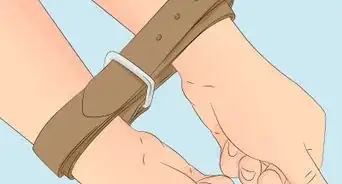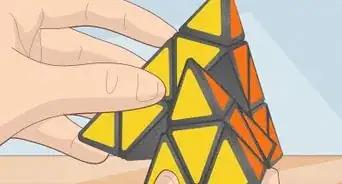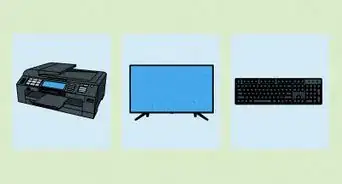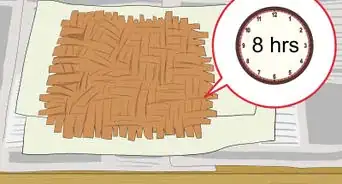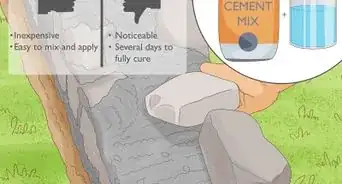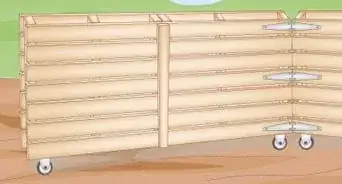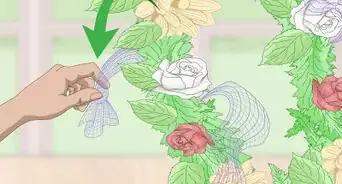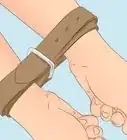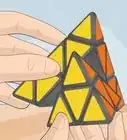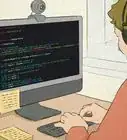This article was co-authored by wikiHow staff writer, Jessica Gibson. Jessica Gibson is a Writer and Editor who's been with wikiHow since 2014. After completing a year of art studies at the Emily Carr University in Vancouver, she graduated from Columbia College with a BA in History. Jessica also completed an MA in History from The University of Oregon in 2013.
There are 10 references cited in this article, which can be found at the bottom of the page.
The wikiHow Video Team also followed the article's instructions and verified that they work.
This article has been viewed 23,389 times.
Learn more...
You're almost done making a sweatshirt and now it's time to finish the sleeves. Ribbing might look tricky, but it's really not hard to create ribbed cuffs for your project. The ribbed material is slightly stretchy so the cuffs can stretch around your hands. You can also use this method to replace worn-out cuffs from a much-loved sweatshirt that's already in your closet.
Steps
Preparing the Fabric and Pattern
-
1Cut out the cuff pattern that's in your sweatshirt pattern. If you're sewing an entire sweatshirt, you probably have a paper pattern that's labeled with sweatshirt pieces. Look for the rectangle that's labeled "cuff" and cut it out with scissors. Keep in mind that there will only be 1 pattern piece, but you'll use it to cut out 2 pieces of fabric to make 2 cuffs.
- Look closely at the cuff pattern to see if there are sizing options. There might be lines for a small, medium, large, or extra-large sweatshirt, for instance. Use the one for the size sweatshirt you're making.
-
2Create your own cuff pattern if you aren't working from a pattern. Don't have a cuff pattern? Don't worry! Just wrap a measuring tape around the end of the sleeve. Multiply this measurement by 0.85 to find the length for the cuff pattern. Then, decide how wide you want your cuff to be and multiply it by 2. Add 1 inch (2.5 cm) to this measurement for a seam allowance and cut out a rectangle with your measurements on a piece of paper.[1]
- For example, if the end of your sleeve measures 7 inches (18 cm) long, your cuff rectangle should be 5.95 inches (15.1 cm) long. If you'd like a 2 in (5.1 cm) cuff, multiply that by 2 and add 1 inch (2.5 cm) to get 5 inches (13 cm). So, your custom cuff pattern would be a 5.95 in × 5 in (15.1 cm × 12.7 cm) rectangle.
Advertisement -
3Buy 1⁄4 yard (0.23 m) or a fat quarter of ribbed fabric for the cuffs. Cuffs are also a great way to use up leftover fabric from another project since you don't need very much material. It is important to use ribbed fabric so your cuff has some stretch—just choose fabric that matches the color of your sweatshirt.[2]
- Want the cuffs to stand out? Pick a contrasting color if you want the cuffs to pop! For example, brighten up a gray sweatshirt with bold blue or green cuffs.
-
4Pin the pattern to the fabric and cut out 2 cuffs for your sweatshirt. Spread your ribbed fabric flat on your work surface and lay the cuff pattern on the fabric so the ribbing is parallel with the short side or height of your cuff pattern. Then, use scissors or a rotary cutter to cut out the pattern piece. Move the pattern and cut 1 more cuff for your sweatshirt.[3]
Sewing the Cuffs
-
1Fold the short ends of the cuff in half and pin the edge together. Lay the cuffs so the right side of the fabric faces up. To fold your fabric in half, take a short side and fold it over to the opposite side. Line up the edges and stick a couple of sewing pins along it so the fabric doesn't shift around. Repeat this for the other cuff.[4]
- The short side is the height of the cuff.
- If you don't like using sewing pins, use sewing clips instead.
-
2Sew along the edge you pinned, leaving a 5⁄8 inch (1.6 cm) seam allowance. Since you won't be sewing across the stretchy ribbing, set your sewing machine to make straight stitches. Then, sew the pinned edge together—don't forget to remove the pins as you sew around the cuff.[5]
- Repeat this for the other cuff so you have 2 tube-like pieces total.
-
3Fold half of the tube out and line up the raw edges. Take your tube, which is now completely inside out, and stick your thumbs into the center of the tube. Use your fingers to fold the raw edge over and keep rolling until the raw edges line up. Repeat this for the other cuff.[6]
- Now your cuff is right side out and the seam you just sewed is hidden on the inside.
-
4Pin the raw edges together and zigzag stitch along the edge. Stick 3 or 4 sewing pins through the ribbed fabric to hold the edges together so they're easier to sew. Then, adjust your sewing machine to make zigzag stitches and start sewing along the very edge of the folded cuff. Sew around the entire cuff until you reach your starting point and repeat this for the other cuff.[7]
- Sewing the zigzag stitch along the edge finishes the raw edges so they won't fray over time.
- Check that you're not sewing through all 4 layers of fabric or you'll accidentally stitch the cuff closed!
Attaching the Cuffs
-
1Stick 4 sewing pins evenly around the sleeve edge and around the cuff edge. Take a sewing pin and push it through the seam at the raw edge of your sweatshirt. Keep the sweatshirt right side out and stick 3 more pins along the edge, leaving equal space between each. Then, repeat this on the cuff.[8]
- You'll need to repeat this step for the other sleeve and cuff.
- Marking the sleeve and cuff with sewing pins just makes it easier to line them up so you don't have fabric bunching as you sew.
-
2Slide the cuff onto the sleeve and line up the pins. Slip the sewn cuff onto the sleeve so the sewn edge is on the raw edge of the sweatshirt. Then, line up the pin that's on the cuff seamline with the pin that's on the sweatshirt seamline. Push each sweater pin through the cuff and repeat this for the other cuff.[9]
- The sweatshirt sleeve is slightly wider than the cuff, which is why you stick the sweatshirt sewing pins through the cuff—you're redistributing some of that excess fabric.
-
3Sew a zigzag stitch around the cuff to attach it to the sleeve. Stretch the edge of the sleeve until the cuff and sleeve are smooth. Then, start sewing a zigzag stitch and leave a 5⁄8 inch (1.6 cm) seam allowance. Sew around the entire cuff until you reach the point where you started. Don't forget to take out the pins as you go, and sew the other cuff.[10]
- Remember to check that you're not sewing the sleeve shut as you stitch around the cuff.
-
4Trim the excess fabric up to the seamline and fold the cuff out. Take a pair of sharp scissors and carefully cut off the extra fabric along your seamline. Be really careful that you don't cut into the stitches! Then, unfold the cuff so it extends away from the sleeve. Repeat this for the other cuff.[11]
- If you don't have enough fabric to trim, don't worry about it. You can just unfold the cuff.
-
5Topstitch around the cuff to give your sleeve a polished finish. At this point, your cuffs are done, but taking a few minutes to topstitch really gives your sweatshirt a professional look. Keep your machine set to a zigzag stitch and sew directly onto the top seam where your sleeve meets the cuff. Then, topstitch the other cuff.[12]
- Some sleeves also have a straight topstitch below the seamline. If you want to add more topstitching, make sure you're straight stitching into the sleeve and not the cuff so you can stretch it when you put on the sweatshirt.
Things You'll Need
- Sweatshirt pattern or a piece of paper
- Sweatshirt
- Ruler
- Sewing machine
- Scissors or rotary cutter and mat
- 1⁄4 yard (0.23 m) of ribbed fabric
- Sewing pins
References
- ↑ https://youtu.be/DxkbTWViGlA?t=83
- ↑ https://youtu.be/XeEM2YvpRSw?t=80
- ↑ https://youtu.be/DxkbTWViGlA?t=103
- ↑ https://youtu.be/DxkbTWViGlA?t=156
- ↑ https://youtu.be/DxkbTWViGlA?t=169
- ↑ https://iamsewcrazy.com/2020/04/24/how-to-replace-worn-out-cuffs-and-neckband-on-a-sweatshirt/
- ↑ https://youtu.be/DxkbTWViGlA?t=231
- ↑ https://iamsewcrazy.com/2020/04/24/how-to-replace-worn-out-cuffs-and-neckband-on-a-sweatshirt/
- ↑ https://youtu.be/DxkbTWViGlA?t=340


